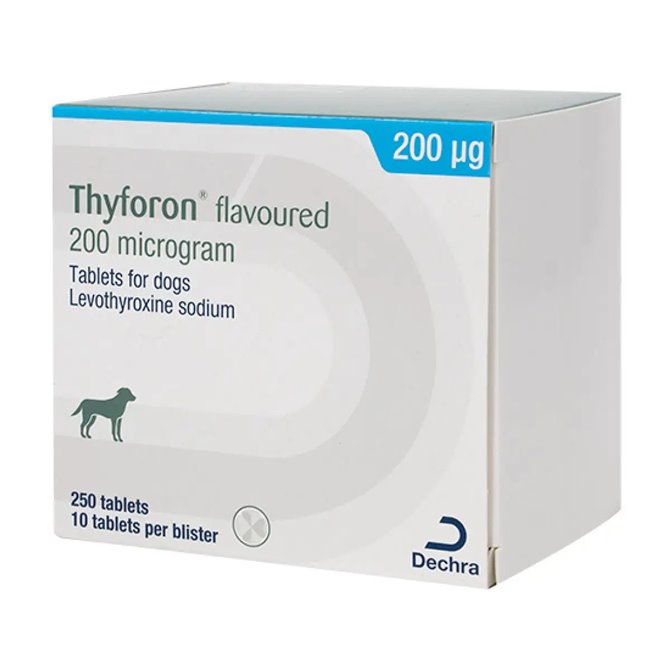
Thyforon 200 Tablet for Dogs - per Tablet
710283
Thyforon 200 is a veterinary medication used to treat hypothyroidism in dogs. It contains levothyroxine sodium, a synthetic form of the thyroid hormone thyroxine (T4), which is essential for regulating metabolism, energy levels, and overall health. Thyforon 200 is available in tablet form and is prescribed by veterinarians to manage thyroid hormone deficiencies in dogs.
Hypothyroidism is a common endocrine disorder in dogs, leading to symptoms such as weight gain, lethargy, hair loss, and skin problems. Thyforon 200 helps restore normal thyroid hormone levels, alleviating these symptoms and improving the dog’s quality of life.
How Thyforon 200 Works
Thyforon 200 contains levothyroxine sodium, a synthetic version of thyroxine (T4), which is the hormone naturally produced by the thyroid gland. In dogs with hypothyroidism, the thyroid gland does not produce enough thyroxine, resulting in a slow metabolism and a range of health problems.
When administered as prescribed, Thyforon 200 supplements the missing thyroid hormone, restoring normal metabolic function. The body converts levothyroxine into triiodothyronine (T3), the active form of the hormone. This process helps regulate energy levels, body temperature, heart rate, and overall well-being.
Product Features
- Pack Size: - Sold Individually
- Target Animal: - Dog (Canine)
- Related Condition: - For the treatment of hypothyroidism in dogs
- Pet Prescription Required?: - Yes
- Active Ingredient: - Levothyroxine Sodium
- Product Name: - Thyforon 200 (Forthyron) Tablet for Dogs - per Tablet
More Information
Description
Thyforon may only be supplied with a valid veterinary prescription issued by your vet. You should only purchase Thyforon if you have or are in the process of arranging such a prescription. See information bar for further details.
Signs of Hypothyroidism in Dogs
Hypothyroidism is most commonly diagnosed in middle-aged and older dogs. The condition is caused by an underactive thyroid gland, leading to a deficiency in thyroid hormones. The symptoms of hypothyroidism can develop gradually and may include:
- Unexplained weight gain despite a normal diet
- Lethargy and reduced activity levels
- Hair loss, particularly on the tail and trunk
- Dry, brittle coat and flaky skin
- Increased sensitivity to cold temperatures
- Slow heart rate (bradycardia)
- Recurring skin infections
- Mental dullness or reduced alertness
Since these symptoms can also be associated with other health conditions, a veterinarian will conduct blood tests to confirm a diagnosis of hypothyroidism before prescribing Thyforon 200.
Administration and Dosage
Thyforon 200 is a prescription-only medication and should only be given under veterinary guidance. The dosage is determined based on the dog’s weight, severity of hypothyroidism, and response to treatment. Regular monitoring is required to ensure the correct dosage is maintained.
The tablets are flavoured to make administration easier. They can be given directly to the dog or mixed with food. It is important to follow the veterinarian’s instructions precisely and to give the medication at the same time each day to maintain stable hormone levels.
Monitoring and Adjustments
Dogs receiving Thyforon 200 require regular blood tests to assess thyroid hormone levels. Adjustments to the dosage may be needed to ensure optimal treatment. Initial blood tests are typically conducted four to six weeks after starting treatment, followed by periodic monitoring as recommended by the veterinarian.
Owners should monitor their dog’s response to treatment and report any concerns to their veterinarian. Improvements in energy levels, coat condition, and overall health are usually observed within a few weeks of starting Thyforon 200.
Potential Side Effects
Thyforon 200 is generally well tolerated when administered at the correct dosage. However, excessive levels of thyroid hormone in the bloodstream can cause signs of hyperthyroidism, including:
- Increased heart rate
- Excessive thirst and urination
- Restlessness or hyperactivity
- Diarrhoea or vomiting
- Weight loss despite a good appetite
If any of these symptoms occur, veterinary advice should be sought immediately, as dosage adjustments may be required.
Legal category
Thyforon 200 is a POM-V (Pet Prescription Required)
You may also like
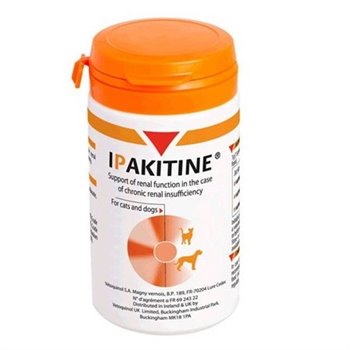
Ipakitine Powder for Kidney Failure - 60g
Ipakitine Powder for Dogs and Cats – Support for Chronic Kidney Function
Ipakitine Powder is a nutritional supplement formulated to support kidney function in dogs and cats suffering from chronic renal insufficiency. It contains a combination of active ingredients that help manage phosphate levels and support metabolic balance, which are essential in the long-term management of chronic kidney disease (CKD). Ipakitine is typically used alongside a renal diet and under veterinary supervision.
Chronic renal insufficiency, also known as chronic kidney disease, is a progressive condition that affects the kidneys' ability to filter waste products and maintain fluid and electrolyte balance. It is particularly common in older cats and dogs, although it can occur at any age due to genetics, infections, or other underlying health conditions. Managing CKD requires a comprehensive approach that includes dietary changes, medications, and supportive supplements such as Ipakitine.
Understanding Chronic Renal Insufficiency in Dogs and Cats
The kidneys perform several vital functions in the body, including removing waste products from the bloodstream, regulating fluid and mineral levels, producing hormones, and helping to maintain blood pressure. In animals with chronic renal insufficiency, kidney function gradually declines over time. As this happens, waste products such as urea and creatinine accumulate in the blood, leading to a variety of clinical symptoms.
60g Pot
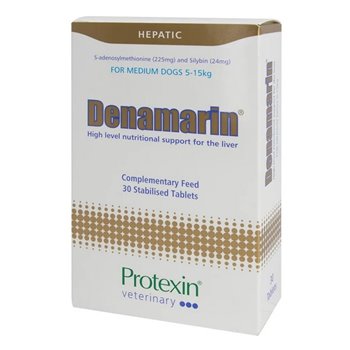
Protexin Denamarin Liver Supplement 225mg Tablets for Medium Dogs - Pack of 30
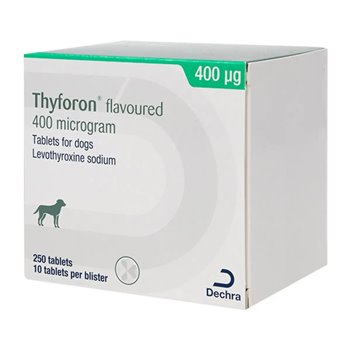
Thyforon 400 Tablet for Dogs - per Tablet
Thyforon 400 is a veterinary medication designed to treat hypothyroidism in dogs. It contains levothyroxine sodium, a synthetic form of thyroxine (T4), which replaces the deficient thyroid hormone. This condition affects a dog’s metabolism, energy levels, and overall well-being. Thyforon 400 helps restore thyroid hormone levels, alleviating symptoms and supporting normal physiological functions.
Hypothyroidism is a common endocrine disorder in dogs, typically caused by autoimmune destruction of the thyroid gland or idiopathic atrophy. The condition results in a slowed metabolism, weight gain, lethargy, and poor coat quality. Thyforon 400 is a prescription medication and must be administered under veterinary supervision.
How Thyforon 400 Works
Thyforon 400 contains levothyroxine sodium, which acts as a replacement for thyroxine (T4), the hormone normally produced by the thyroid gland. Thyroxine is essential for regulating metabolism, body temperature, cardiovascular function, and skin and coat health.
When a dog has hypothyroidism, the thyroid gland fails to produce sufficient hormones, leading to metabolic slowdown and a range of health problems. By supplementing the missing hormone, Thyforon 400 restores normal metabolic activity. The body converts levothyroxine into triiodothyronine (T3), the active form of the hormone, which supports proper organ function and energy regulation.
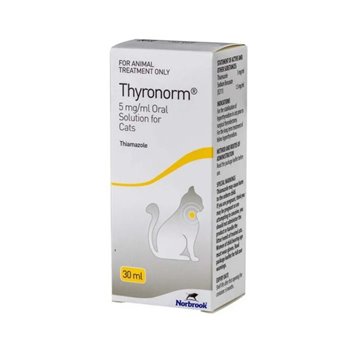
30ml Thyronorm for Cats 5mg/ml Oral Solution
Managing Hyperthyroidism in Cats
Thyronorm 30ml is a veterinary medicine formulated to treat hyperthyroidism in cats. It contains the active ingredient thiamazole, which helps regulate the production of thyroid hormones. Hyperthyroidism is a common condition in older cats, leading to weight loss, increased appetite, hyperactivity, and other metabolic changes.
Hyperthyroidism occurs when the thyroid gland produces excessive amounts of thyroxine (T4), a hormone responsible for regulating metabolism. Elevated thyroid hormone levels can cause a range of symptoms that affect a cat’s overall health. Without treatment, the condition can lead to complications affecting the heart, kidneys, and other organs.
Thyronorm helps control thyroid hormone production, restoring balance to the cat’s metabolism. Proper management of hyperthyroidism can improve quality of life and reduce the risk of long-term complications.
How 30ml Thyronorm Works
Thyronorm contains thiamazole, a medication that inhibits the excessive production of thyroid hormones. It works by blocking the enzyme thyroid peroxidase, which is essential for the synthesis of thyroxine (T4) and triiodothyronine (T3). By reducing hormone production, Thyronorm helps regulate metabolism and alleviates the symptoms of hyperthyroidism.
Thiamazole does not cure hyperthyroidism but provides ongoing management of the condition. Regular administration is necessary to maintain stable thyroid hormone levels. Adjustments to dosage may be required based on veterinary monitoring and blood test results.
VET PRESCRIPTION REQUIRED




